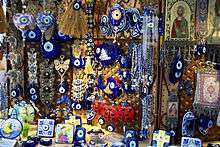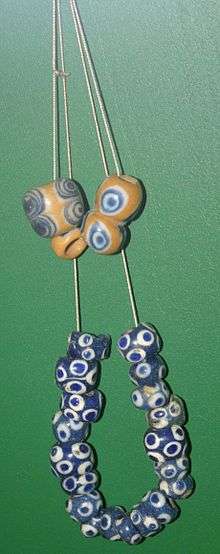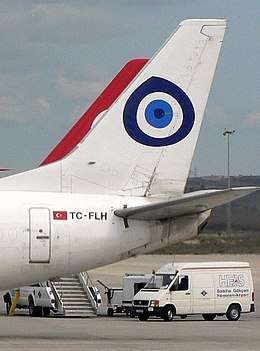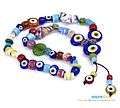Nazar (amulet)
A nazar (from Arabic نَضَر Arabic pronunciation: [naðˤar], word deriving from Arabic, meaning sight, surveillance, attention, and other related concepts) is an eye-shaped amulet believed to protect against the evil eye. Hindi-Urdu, Pashto, Bengali, Kurdish, Persian, Punjabi, and other languages have borrowed the term as well.[1] In Turkey, it is known by the name nazar boncuğu (the latter word being a derivative of boncuk, "bead", and the former borrowed from Arabic) and historically as mâvi boncuk or Old Turkic: gökçe munçuk, both meaning "blue bead".[2] In Persian and Afghan folklore, it is called a cheshm nazar (Persian: چشم نظر) or nazar qurbāni (Persian: نظرقربانی).[3] In India and Pakistan, the Hindi-Urdu slogan Chashm-e-Baddoor is used to ward off the evil eye.[4] In the Indian subcontinent, the phrase "Nazar lag gai" is used to indicate that one has been affected by the evil eye.[5]

It is commonly believed that the evil eye can be given in the guise of a compliment, signifying its connection to the destructive power of jealousy. Amulets such as the Nazar are used in accordance with common sayings such as "an eye for an eye", where another eye can be used to protect the recipient of the malefic gaze.[6] The evil eye causes its victim to become unwell the next day, unless a protective phrase such as "With the will of God" ("MashAllah" in Arabic) is recited.[7] Among adherents of Hinduism and Islam in South Asia, when a mother observes that her child is being excessively complimented, it is common for them to attempt to neutralize the effects of the evil eye (nazar utarna) by "holding red chillies in one hand and circling the child's head a few times, then burning the chillies."[8][9]
Amulet
A typical nazar is made of handmade glass featuring concentric circles or teardrop shapes in dark blue, white, light blue and black, occasionally with a yellow/gold edge.[10]
It is a common sight in Turkey, North Macedonia, Albania, Bosnia and Herzegovina, Bulgaria, Greece, Cyprus, Afghanistan, Syria, Lebanon, Israel, Egypt, Armenia, Iran, Pakistan, India, Iraq, Algeria, Azerbaijan, Morocco, Tunisia[11], and some regions of Georgia, where the nazar is often hung in homes, offices, cars, children's clothing, or incorporated in jewelry and ornaments.[10] They are a popular choice of souvenir with tourists.
Eye bead

The Turkish boncuk (sometimes called a göz boncuğu 'eye bead') is a glass bead characterized by a blue glass field with a blue or black dot superimposed on a white or yellow center. Historically old, the blue bead has gained importance as an item of popular culture in Modern Turkey. The bead probably originated in the Mediterranean and is associated with the development of glass making. Written documents and extant beads date as early as the 16th century BC. Glass beads were made and widely used throughout the ancient world: from Mesopotamia to Egypt, from Carthage and Phoenicia to Persia, and throughout the Roman imperial period.
The eye bead is a kind of glass art based on nazar in Turkey. This art has changed very little for thousands of years. The 3,000-year-old antique Mediterranean glass art lives in these eye bead furnaces with its every detail.
The roots of the very few glass evil eye bead masters that still practice this tradition go back to the Arabian artisans who settled in Izmir and its towns during the decline of the Ottoman Empire by the end of the 19th century. The glass art that had lost its glamour in Anatolia, combined with the eye sign, was enlivened. The masters who practised their arts at Araphan and Kemeraltı districts of Izmir were exiled due to the disturbance of the smoke from their furnace and risk of fire in the neighbourhood.
Other uses and popular culture

The nazar image was used as a symbol on the tailfins of aeroplanes belonging to the private Turkish airline Fly Air.
It is used in the logo for CryEngine 3, a game engine designed by Crytek, a video game company founded by three Turkish brothers (Cevat, Avni and Faruk Yerli).
It was also used in the logo of the 2013 FIFA U-20 World Cup events.
The video game Terraria (2011) has an accessory item called "Nazar" which grants immunity to the "Cursed debuff", referencing how a nazar is used to protect the wearer from curses and bad Luck.
The video game Crypt of the Necrodancer has a pick up called the "Nazar Charm" which wards off all forms of ghosts while it is held.
The video game series The Legend of Zelda has the Sheikah tribe's eye symbol, typically indicating arcane knowledge and protection against evil.
In 2018, the Nazar Amulet became an emoji as part of Emoji 11. It was first put into use on Twitter as a part of its Twemoji feature on June 5, 2018. It uses the code U+1F9FF 🧿 .[12]
Gallery
 Nazar Amulet
Nazar Amulet Turkish Nazar Eye Beads
Turkish Nazar Eye Beads Nazar-inspired sculpture in the Netherlands.
Nazar-inspired sculpture in the Netherlands. Nazar evil eye charms.
Nazar evil eye charms.- A Persian cheshm nazar.
- A Turkish nazar boncuğu.
 Nazar on a newborn baby's hospital room door in Turkey.
Nazar on a newborn baby's hospital room door in Turkey.
See also
References
- Khan, Abdul Jamil (2006). Urdu/Hindi: An Artificial Divide: African Heritage, Mesopotamian Roots, Indian Culture & British Colonialism. Algora Publishing. p. 138. ISBN 9780875864389.
Arabic verbs have generated an enormous number of words for Urdu/Hindi as well as Persian. ... The word nazar, meaning eye, or sight, is part of the cultural idiom -- <nazar lag jana>, meaning 'evil eye's effect,' and is used in the whole subcontinent.
- There is uncertainty about the spelling. Moncuk, monçug, muncug, monsak, and similar variations have all been seen.
- M. Moin: A Persian Dictionary, 3rd edition, p. 4752 (in Persian).
- South Asian Cinema, Volume 1, Issue 1. South Asian Cinema Foundation. 2001. p. 61.
- Mehmet Kaan Kaya, Arun D Singh, Harminder S Dua (22 May 2009). "Nazar boncugu—blue glass Evil Eye bead". British Journal of Ophthalmology. 93 (707). Retrieved 13 May 2019.
The phrases “Nazar lag gai” (affected by the Evil Eye) and “Nazar utarna” (removing the effects of Evil Eye) are common in Hindu culture.
CS1 maint: multiple names: authors list (link) - Dundes, Alan. (1992). The evil eye : a casebook ©1981. University of Wisconsin Press. ISBN 0-299-13334-6. OCLC 863469680.
- Giger, Joyce Newman (29 January 2016). Transcultural Nursing. Elsevier Health Sciences. p. 351. ISBN 9780323400046.
- Shankar, Vijay N. (20 August 2014). Shadow Boxing with the Gods. Leadstart Publishing. p. 43. ISBN 9789381836804.
- Valsiner, Jaan (2 February 2000). Culture and Human Development. SAGE Publications. p. 182. ISBN 9780761956846.
In Rajastan (India) the treatment of the 'evil eye' includes seven red chilis and some salt circled over the head of the sick child before these are thrown into the hearth.
- Lonely Planet Middle East.Lonely Planet; 6 edition, 2009, p. 559.
- Stoltz, Dustin (May 26, 2012). "The Evil Eye and Mountain Karma in Azerbaijan". www.dustinstoltz.com. Archived from the original on November 23, 2016.
- "Twemoji 11.0 Emoji Changelog". Emojipedia. 2018-06-05. Retrieved 2018-06-14.
Sources
- Ronald T. Marchese (2005). The Fabric of Life: Cultural Transformations in Turkish Society. pp. 103–107.
External links

- http://www.ancientpages.com/2018/03/13/nazar-amulet-blue-color-wards-off-the-evil-eye-according-to-ancient-belief/
- https://www.wemystic.com/nazar/